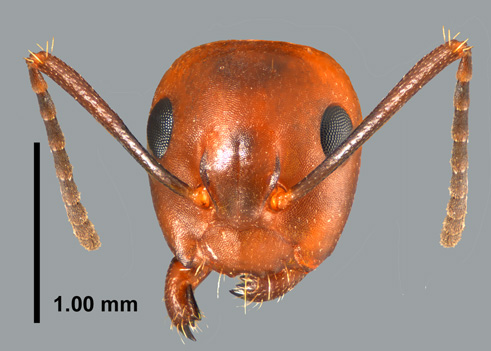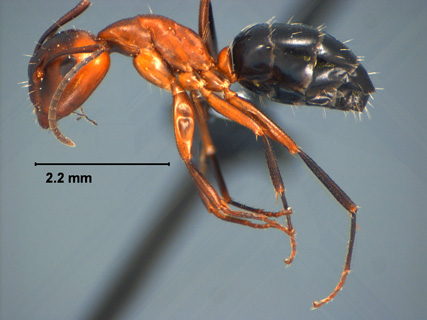Camponotus decipiens, frontal view of the head of a minor worker.
(click image to enlarge) |
Camponotus decipiens, profile view of a worker.
(click image to enlarge) |
Introduction
Ants in the genus Camponotus are collectively known as carpenter ants because some species nest in wood, including man-made structure. This genus includes some of the largest and most common ants in the world, and they are found in all biogeographical regions (Bolton, 1995). More than 900 species of Camponotus are known worldwide, with 50 species reported from the United States (Hanson and Klotz, 2005), and 20 species found east of the Mississippi River (Deyrup, 2003; Smith, 1979).
Species in this genus are variable in size with workers ranging in size from 3 to 15 mm or more in length and queens (also referred to as females) of some species attaining a length of 19 mm or more. Many species are polymorphic. Workers have a 12-segmented antenna that lacks an apical club. Antennal fossae do not touch the posterior border of the clypeus. Ocelli are not present on the heads of workers. The workers of most species have an indistinct metanotal suture between the promesonotum and the propodeum, although this suture is present in C. sexguttatus and some members of the subgenus Colobopsis. Those species that lack the obvoius and deep metanotal suture have the shape of the alitrunk in a smoothly curved arc (as seen in profile).
This species is in the subgenus Myrmentoma, which can be generally characterized as having a notch or emargination in the middle of the anterior border of the clypeus.
Identification
Camponotus decipiens Emery workers range from 3.5 to 7.5 mm in overall length. This species can be distinguished from others in the subgenus by the lack of erect hairs on the gena, and scarcity of erect hairs on the clypeal disc and by the color which is a reddish head, alitrunk, legs, and petiole and a blackish gaster. Some consider this species, C. snellingi, and C. nearcticus color forms and in that case the name Camponotus nearcticus has priority. Camponotus snellingi tends to be larger in overall size, and individuals have similar coloration to C. decipiens, but also usually have the first two tergites of the gaster yellowish red. C. snellingi usually has larger nests as well, and are frequently found in large colonies in dead trees, often still standing. Camponotus nearcticus is concolorous dark brown to black. Both C. nearcticus and C. snellingi usually have more erect hairs on the clypeus than C. decipiens.
Biology and Economic Importance
This species
typically has relatively small colonies with less than 100 workers and at most a few hundred workers. They often nests in galleries created by other insects (including carpenter ants in the subgenus Colobopsis) in twigs and branches of trees, in insect galls, in cavities in the stalks of plants, in large seed pods, under bark of trees, in logs and stumps, wooden posts, and in houses. In this region, we have collected alates both in the Fall and the Spring.
Distribution
Literature Cited
Links
AntWeb Images
Discover Life Images |




